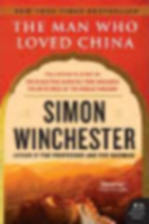Giving China Due Credit
Giving China Due Credit
By staff reporter SUE DUNCAN

The Man Who Loved China
By Simon Winchester
352 pages
US $15.99 (paperback)
Published in US by Harper Perennial
THINK in oceans." It was a piece of childhood advice that the British scientist Joseph Needham (1900-1994) took to heart. This approach resulted in Science and Civilization in China, a prodigious work described as "the greatest single act of historical synthesis and intercultural communication ever attempted by one man."
The project's inspiration, genesis, and execution encompassed a host of elements – the privileges of an ancient Cambridge college, a war-ravaged China, towering intellect, energy and ambition, a moving love story, an unconventional marriage, academic backbiting, social ostracism, political confrontation and friends in high places.
Needham's Chinese name, Li Yuese, needs no introduction in China. It is revered for combating ignorance about China's historic contribution to science and technology, confounding Western assumptions of superiority in this sphere. Joseph Needham is relatively unknown in the West, but that may change now that Simon Winchester has woven together the strands of Needham's remarkable life and work to produce a riveting read.
The narrative starts in the wartime capital of Chongqing 1943, with the arrival of a man with a mission: contact beleaguered Chinese universities fleeing destruction by Japan and supply them with desperately needed equipment via the air bridge over "the Hump."
It was a British diplomatic mission, but there is a personal agenda too. Needham's desire to experience and help China was inspired by love of Lu Gwei-djen (sic), who arrived in 1937 from Nanjing to study under his wife Dorothy, herself a distinguished biologist, and apparently happy with an open marriage. Smoking a post-coital cigarette Needham asks how to write the Chinese word for "smoke." The answer, unveiling a totally new concept in language, fires him to start studying Chinese in earnest, so that when his plane bounces down in Chongqing five years later, he can "speak Chinese as they do in Nanjing" and handle classical Chinese too.
The relationship with Lu brings the realization that many scientific discoveries and inventions in China predate by centuries, millennia even, their appearance in the West. Investigating such things in situ becomes Needham's second obsession and unofficial task. Needham notes and follows up every lead about possible "Chinese firsts" – gunpowder, a flying machine for example – often at great personal risk.
Of his 11 expeditions in the interior, arguably the first journey, west to Chengdu, is most significant for his own project. On this he meets two Chinese scholars, later to become vital collaborators. The first, Huang Hsing-tsung, will become Needham's secretary and companion during his later journeys, and decades later produce one volume of the great work. The second is Wang Ling, historian at an Academica Sinica outpost in Lizhuang. Inspired by an impromptu lecture by Needham, its members ferret out early references such as "passages about firecrackers in the 2nd century AD" indicating that gunpowder in China went back at least a millennium before Europeans "invented" it. Wang's help is priceless as the history grows from idea, to outline, to output.
These were extraordinary times, peopled and shaped by extraordinary individuals. Many have walk-on parts in the nail-biting narrative as Needham makes arduous journeys north to Dunhuang and east to Fuzhou, buying books and documents that will become source material for Science and Civilization.
He leaves in March 1946, invited back to Europe to help form UNESCO, but CIA suspicion of his leftwing affiliations forces his resignation. And by March 1948 he is back at Caius College. It is time for the book to be born. Within two months a 12-page proposal is on its way to Cambridge University Press. The first plan is for one large volume, rapidly revised to seven, to be produced with 10 years: the current reality is 24 volumes so far, with more in preparation. Adroitly clearing the narrative path, Winchester corrals the inventions into an appendix, dating the first mentions of some 200 Chinese inventions – e.g. abacus (190 AD), segmental arch bridge (610 AD), woodblock printing (C7th AD), anti-malaria drugs (C3rd BC).
Despite political controversy about his scientific impartiality, when Volume 1 comes out in August 1954 it is to a triumphant reception. Subsequent volumes, many described as masterpieces, cement his own reputation and help dispel the ignorance and condescension clouding modern Western attitudes to China. Honors follow.
A co-founder of the Society for Anglo-Chinese Understanding and staunch supporter of New China, Needham makes several return visits, being met in 1964 by his old friend Premier Zhou Enlai, and in 1972 he meets Chairman Mao again. His last visit, in 1982, is to an unrecognizable Chongqing.
The book is full of gossipy nuggets (e.g. Needham's enthusiasm for Naturism, Morris dancing and the ladies!), entertaining footnotes and useful maps, a Chinese chronology and index. The expert handling of such rich material attests to the author's foreign correspondent experience: not one word is redundant. Winchester is a great navigator of this ocean of ideas.
-------------------------------------
Simon Winchester is a British author and journalist who has worked in China on many projects, including The River at the Center of the World, about the Yangtze River.
Services
Economy
- Eco-agriculture and Eco-tourism Power Nanchang’s Green Development
- Balance Environmental Protection and Economic Prosperity – Nanchang Looks to European Technology for Green Development
- Sustainable Growth Requires Wiser Energy Use
- Chinese Economy: On the Path of Scientific Development
- China's Economy over the Last Ten Years

